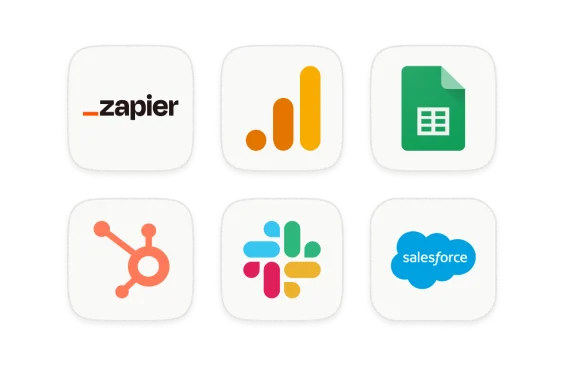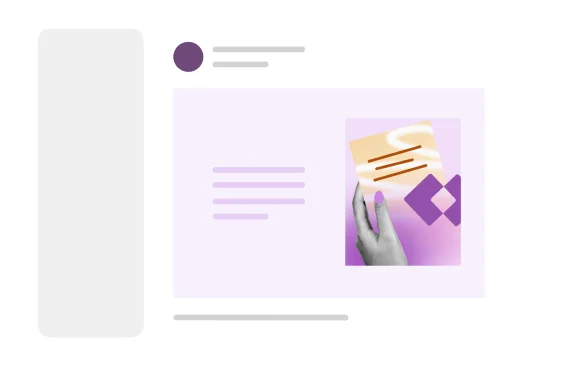Using Hidden Fields
We are currently running an A/B test on the naming of this feature, so you might see URL parameters instead of Hidden Fields in your account.
Hidden Fields are a Free feature that allows you to use data you already have, track information about your respondents, and make your forms more personal.
Hidden Fields can be used for lots of things:
- Track the source of respondents (social media channels, for example)
- Segment your audience for deeper insights and analysis
- Customize your form to make it even more personal
Are you on a Business plan or higher and interested in tracking marketing-related information like respondent source and campaign? Check out our guide to UTM tracking on Typeform here. Not on a Business plan? You can still use UTM parameters as Hidden Fields—read on to learn more!
How do Hidden Fields work?
Hidden Fields allows you to place data that you already have directly in your form URL. You can view all your data in the Results panel.
What types of information can be passed with Hidden Fields?
You can include any information you want, for example:
- The person’s name (so that you can use Recall information to welcome each respondent personally)
- The email of your respondent (so you know who completed the form)
- Traffic source (so that you know where someone saw your form—Facebook, website, etc)
- If you sell shoes, you can even capture the person’s shoe size (so you always have that information stored for future transactions through your forms)

Note! If you add your Google Analytics tracking code to a form, you are responsible for the data collected by Google Analytics. If you’re using Hidden Fields that include personally identifiable information, like name or email address, etc, you must ensure this information is added to the ‘Exclude URL Query Parameters’ field in Google Analytics’ view settings. Collecting this data breaks Google’s Terms of Service. Here’s how to do this.
How to add Hidden Fields to your form
1. Open your form from your workspace. Towards the top of your screen, click Logic. Then click on the Personalize with data option.
Then click Hidden Fields.
2. A new dialog will open where you can add your Hidden Fields.
3. Click the suggested Hidden Fields to add them, or + Add new field to create your own, then type in what you want to name it.
Click the + Add new field button again to add more of your own Hidden Fields as required, then hit Save.
Hidden Fields must be written in lower-case letters.
4. Your Hidden Fields will be added to your form's share URL once you have published it. To see them, head to the Share panel. Click Copy link, then you can paste it wherever you like.
If you want to add information to the Hidden Fields manually, you can do this by pasting your link, and replacing the xxxxx with the word you want.
In our example, the Hidden Field we've added is for tracking the source of our respondents, so we would change xxxxx to "twitter" or "facebook" for sharing on those networks.
Hidden Fields breakdown
After adding Hidden Fields to your form, a string of characters will be added to the URL of the form. Here's an example of how your URL might look with Hidden Fields added:
https://tutorials.typeform.com/to/nzthWI#name=xxxxx&source=xxxxx
In this example, we're placing two parameters into two distinct Hidden Fields, these are:
- name
- source
The “xxxxx” after “name=” and “source=” are the Hidden Fields. The “xxxxx” needs to be replaced with real data for the form to pass the data into your results. You cannot currently populate score and price variables through Hidden Fields.
Using our example above, if Fran was sent their form through Twitter, then the URL would look like this:
https://tutorials.typeform.com/to/nzthWI#name=Fran&source=twitter
Now your form will automatically fill your results with the following data:
- name: fran
- source: twitter
And you won’t have to ask for their data using a question in the form.
You can pass text in the Hidden Field with a space. This can come in handy when passing, for instance, full names, like “Jane Doe”. You need to replace the spaces with “%20” in the URL for the Hidden Field to appear with the space in your results and/or form. So your URL would look like this:
https://example.typeform.com/to/AbCdEf#fullname=Jane%20Doe
And that's not all: you can encode any character using UTF-8 percent encoding.
How do you make this work?
There are 2 ways to implement this feature:
Manually – you manually add information to the Hidden Fields in the URL before sharing your form.
Automated – you can use your CRM system (Salesforce, Infusionsoft, Netsuite, etc.) to populate your data, so up to thousands of people can receive a custom URL form. Please read these articles for more details:
- Populate Hidden Fields with a CRM / Marketing Automation tool
- Automated Hidden Fields with MailChimp
Using Hidden Fields with embedded forms
You can easily add a Hidden Field like “source” to a form that’s already embedded. You can also create multiple embed codes with different Hidden Fields data for the same form.
Let's say you want to track the source so you know which page on your website people complete your form on. You can create an embed code with the Hidden Field data 'homepage' as the source for the homepage on your website. Then create a new embed code with the Hidden Field data 'about' for the About page on your website. You'll then be able to see in your Responses how many respondents answered your form on your homepage or your About page.
Head over to our article on how to use Hidden Fields with embedded forms to learn more.

Note! If you want to pass information to the form URL of an embedded form from outside the iframe, it is possible, but requires some coding skills. Please note that we cannot troubleshoot custom code or give development instructions in the event that something in your custom implementation is not working!
You can also check out our Developer Portal for some more advanced tips on how to use Hidden Fields in embedded forms.
What will it look like when I collect data?
Data from Hidden Fields will appear in your Responses.
In your Responses tab, you can see each individual submission and its Hidden Field data.
Give it a try. Copy this link, paste it in a web browser, and replace the “xxxxx” with your name and an imagined source, like ‘facebook’. Then hit ‘enter’ and see what the form does.
https://successteam.typeform.com/to/nzthWI#name=xxxxx&source=xxxxx

Note! If you edit the name of a Hidden Field that has already been collecting responses, the previously collected responses will also be deleted.
How to use the collected Hidden Fields information in your form
Apart from passing data into your results, you can do two more things with Hidden Fields:
- Add Hidden Fields to a question in your form. Find out how in this article: Recall information
- Use Recall information to set up Logic. Refer to this article to learn more: Use Branching and calculations in Logic to show relevant questions


